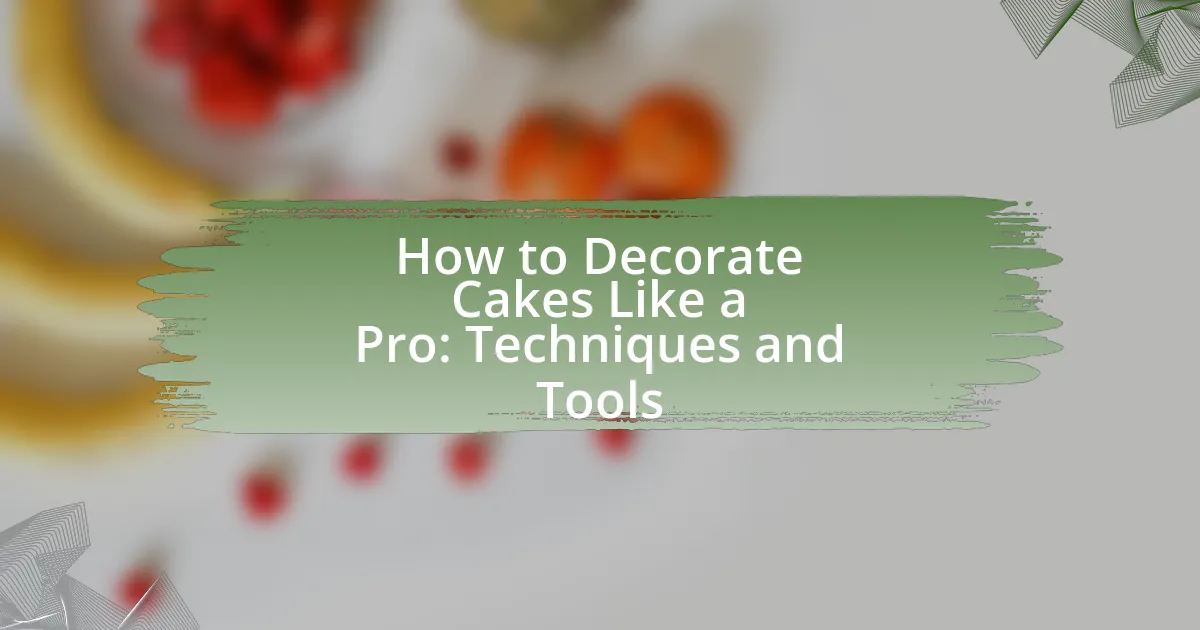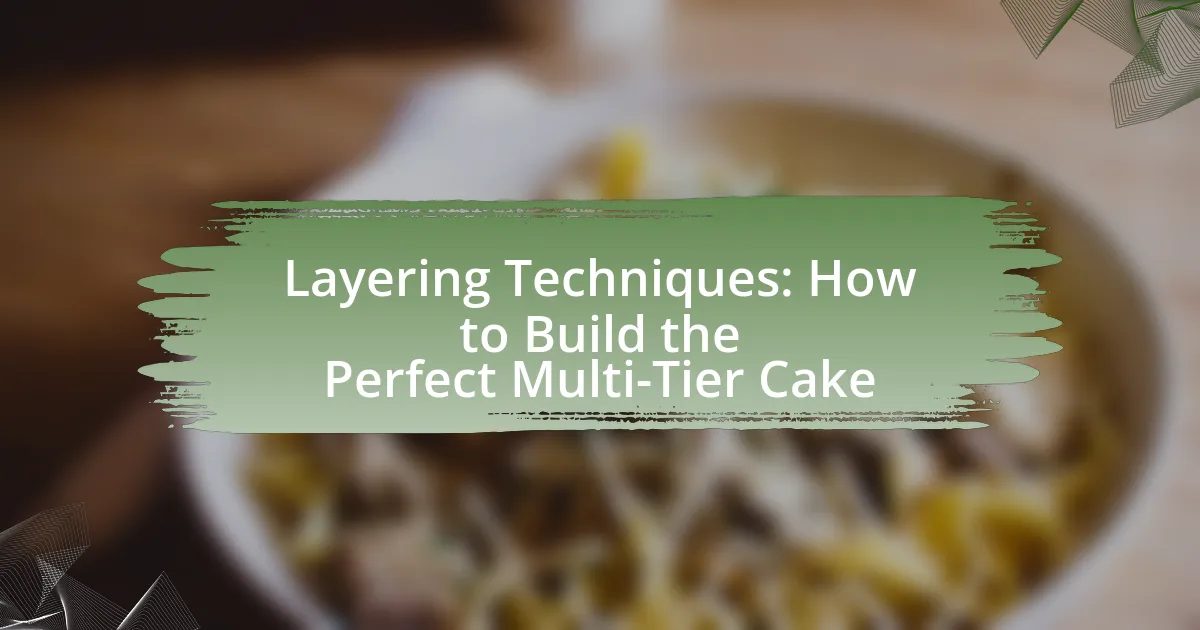The main entity of the article is the art of cake photography, which involves capturing visually appealing images of cakes that emphasize their design, texture, and colors. The article outlines essential techniques for effective cake photography, including the use of natural light, composition strategies, and the importance of understanding cake design to enhance photographic skills. It also discusses the unique challenges cake photography presents, such as managing lighting and angles, and highlights the significance of high-quality images for bakers and pastry chefs in marketing their creations and engaging with customers on social media. Additionally, the article provides practical tips on equipment, camera settings, and editing practices to improve cake photography outcomes.
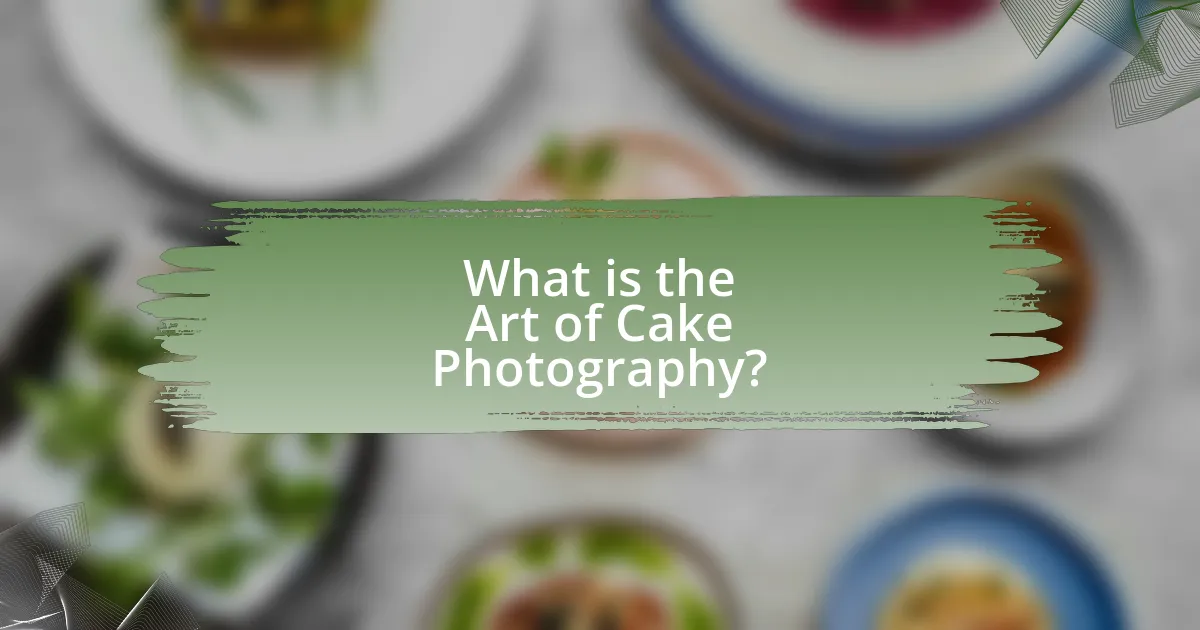
What is the Art of Cake Photography?
The Art of Cake Photography is the practice of capturing visually appealing images of cakes that highlight their design, texture, and colors. This specialized photography focuses on techniques such as lighting, composition, and styling to enhance the cake’s features and create an enticing visual narrative. Effective cake photography often employs natural light to avoid harsh shadows and utilizes angles that showcase the cake’s details, such as frosting and decorations. Additionally, the use of props and backgrounds can complement the cake, making the final image more engaging.
How does cake photography differ from other types of food photography?
Cake photography differs from other types of food photography primarily due to its emphasis on aesthetics and decoration. While general food photography often focuses on the dish’s ingredients and preparation, cake photography highlights intricate designs, textures, and colors that make cakes visually appealing. For instance, the use of lighting and angles in cake photography is crucial to showcase layers, frosting, and embellishments, which are essential elements in cake presentation. This specialized approach is supported by the fact that cakes often serve as centerpieces for celebrations, necessitating a focus on their artistic aspects to evoke emotions and convey the occasion’s significance.
What unique challenges does cake photography present?
Cake photography presents unique challenges primarily due to the intricate details and textures of cakes that require precise lighting and angles to capture effectively. The reflective surfaces of frosting can create glare, making it difficult to showcase the cake’s design accurately. Additionally, the varying colors and patterns in cake decorations can lead to color distortion in photographs, necessitating careful color management during shooting and editing. The three-dimensional nature of cakes also poses a challenge in framing the shot to highlight the cake’s height and layers without distortion. These factors collectively demand a high level of skill and attention to detail from the photographer to achieve visually appealing results.
How can understanding cake design enhance photography skills?
Understanding cake design enhances photography skills by providing a deeper appreciation for composition, color, and texture. Cake design principles, such as balance and focal points, directly translate to effective photographic framing, allowing photographers to create visually appealing images. For instance, knowledge of color theory helps in selecting complementary backgrounds that enhance the cake’s features, while an understanding of texture can guide the use of lighting to highlight intricate details. This synergy between cake design and photography results in more compelling and professional-looking images.
Why is cake photography important for bakers and pastry chefs?
Cake photography is important for bakers and pastry chefs because it visually showcases their creations, attracting customers and enhancing their brand presence. High-quality images can significantly influence consumer purchasing decisions, as studies indicate that 93% of consumers prioritize visual appearance when making food choices. Additionally, effective cake photography allows bakers to display their skills and creativity, which can lead to increased social media engagement and potential sales.
How does effective cake photography impact social media presence?
Effective cake photography significantly enhances social media presence by attracting more engagement and followers. High-quality images of cakes can increase likes, shares, and comments, which are critical metrics for social media algorithms that promote content visibility. According to a study by HubSpot, posts with images receive 94% more views than those without, highlighting the importance of visual appeal in social media interactions. Additionally, visually appealing cake photography can establish a brand identity and differentiate a baker from competitors, leading to increased customer loyalty and word-of-mouth referrals.
What role does cake photography play in marketing baked goods?
Cake photography plays a crucial role in marketing baked goods by visually showcasing the product’s appeal and quality. High-quality images attract potential customers, enhance brand perception, and increase engagement on social media platforms. Research indicates that posts featuring visually appealing food photography can lead to a 94% increase in views and a significant boost in sales, as consumers are more likely to purchase items that they find visually enticing. Thus, effective cake photography not only highlights the artistry of the baked goods but also serves as a powerful marketing tool that drives consumer interest and purchasing decisions.
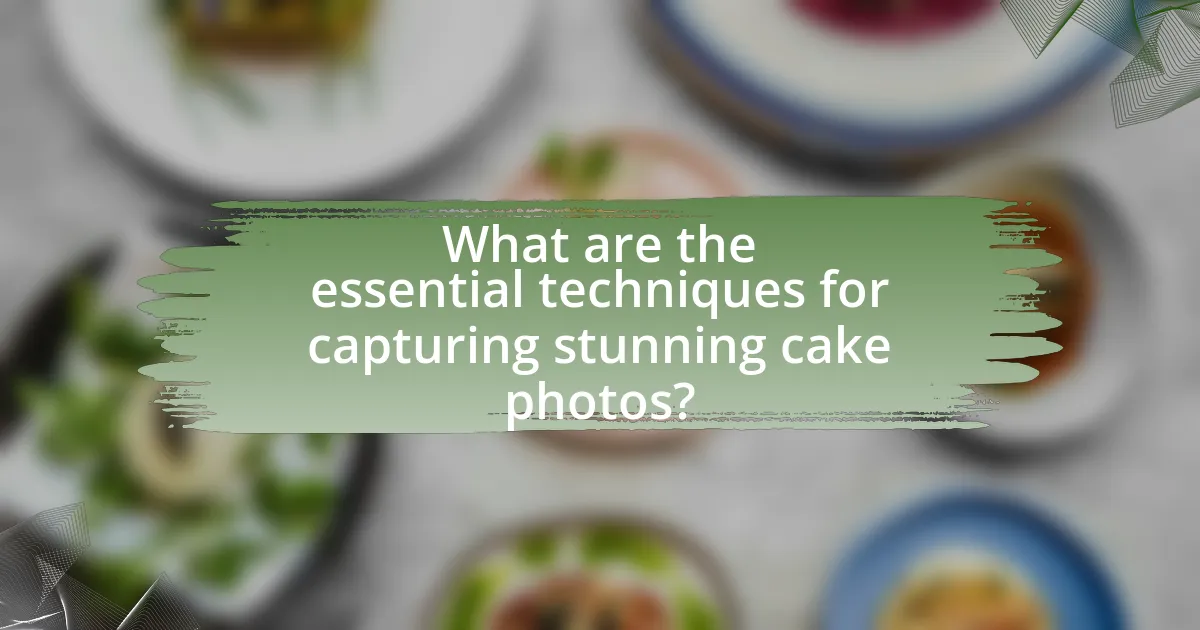
What are the essential techniques for capturing stunning cake photos?
To capture stunning cake photos, essential techniques include using natural light, selecting the right angles, and employing proper composition. Natural light enhances the cake’s colors and textures, making it visually appealing; shooting near a window or outdoors during golden hour is ideal. Choosing angles, such as eye-level or slightly above, can showcase the cake’s height and details effectively. Additionally, applying the rule of thirds in composition helps create balanced and engaging images. These techniques are supported by photography principles that emphasize light, perspective, and framing, which are crucial for achieving high-quality food photography.
How can lighting affect cake photography?
Lighting significantly impacts cake photography by influencing the visibility, texture, and overall aesthetic of the cake. Proper lighting can enhance the cake’s colors and details, making it appear more appetizing and visually appealing. For instance, natural light can create soft shadows that highlight the cake’s texture, while harsh artificial light can lead to unflattering glare and loss of detail. Studies in photography emphasize that diffused lighting, such as that from a softbox or window, can produce a more balanced and inviting image, as it reduces harsh contrasts and brings out the cake’s features effectively.
What are the best lighting setups for cake photography?
The best lighting setups for cake photography include natural light, softbox lighting, and ring lights. Natural light, particularly from a window, provides a soft and flattering illumination that enhances the cake’s details without harsh shadows. Softbox lighting creates a diffused light source, minimizing glare and allowing for even lighting across the cake’s surface. Ring lights offer a uniform light that reduces shadows and highlights the cake’s features effectively. These setups are widely used by photographers to achieve professional-quality images, as they help in capturing the texture and colors of the cake accurately.
How can natural light be utilized effectively in cake photography?
Natural light can be utilized effectively in cake photography by positioning the cake near a window to take advantage of soft, diffused light. This approach minimizes harsh shadows and highlights the cake’s textures and colors, enhancing its visual appeal. Studies in photography emphasize that natural light, particularly during the golden hour, provides a warm tone that can elevate the overall aesthetic of food photography. Additionally, using reflectors can help bounce light onto the cake, further reducing shadows and creating a more balanced exposure.
What composition techniques should be used in cake photography?
In cake photography, effective composition techniques include the rule of thirds, leading lines, and framing. The rule of thirds involves dividing the image into a grid and placing the cake at the intersections or along the lines to create balance and interest. Leading lines guide the viewer’s eye toward the cake, enhancing focus and depth. Framing uses elements in the environment, such as plates or utensils, to create a visual border around the cake, drawing attention to it. These techniques are widely recognized in photography for improving visual appeal and engagement.
How does the rule of thirds apply to cake photography?
The rule of thirds applies to cake photography by guiding photographers to position the cake along the intersecting lines of a grid that divides the image into thirds, both horizontally and vertically. This technique enhances visual interest and balance, making the cake the focal point while allowing for a more dynamic composition. For instance, placing the cake off-center can create a more engaging image, drawing the viewer’s eye naturally to the subject. Studies in visual perception indicate that images adhering to the rule of thirds are often perceived as more aesthetically pleasing, supporting its effectiveness in cake photography.
What angles work best for showcasing cake designs?
The best angles for showcasing cake designs are the eye-level angle and the 45-degree angle. The eye-level angle captures the cake’s details and decorations directly, providing a clear view of the design. The 45-degree angle offers depth and dimension, highlighting the layers and textures effectively. These angles are commonly used in food photography to enhance visual appeal and attract attention, as they allow for a comprehensive representation of the cake’s artistry.
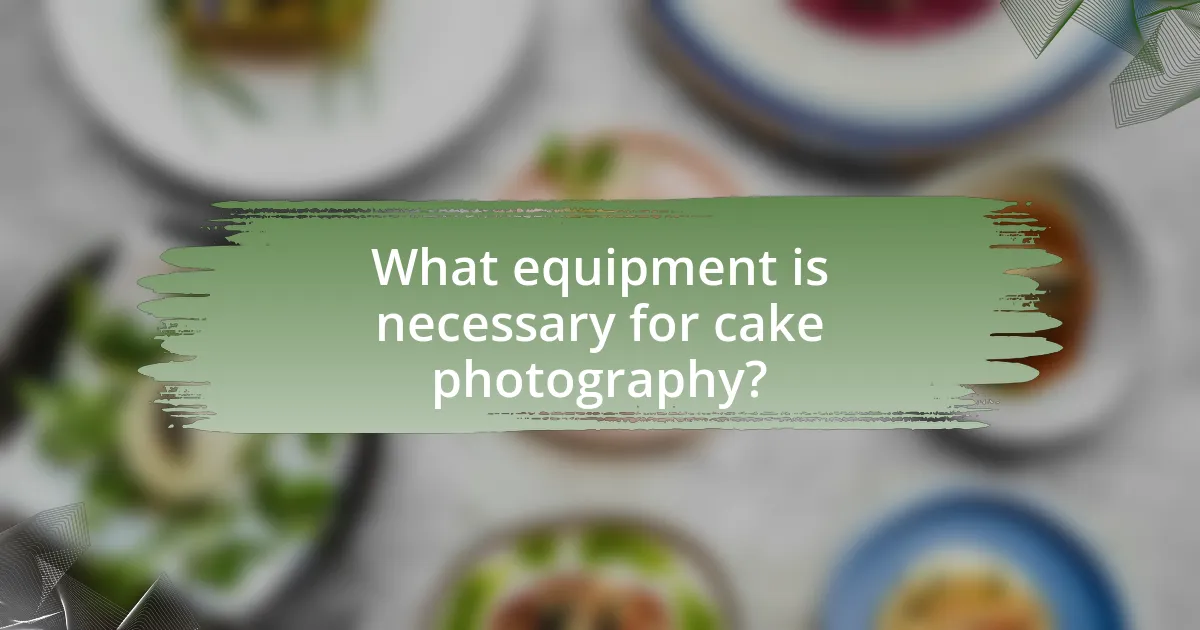
What equipment is necessary for cake photography?
For cake photography, essential equipment includes a DSLR or mirrorless camera, a tripod, and a macro lens. A DSLR or mirrorless camera allows for high-quality images with adjustable settings for lighting and focus, while a tripod stabilizes the camera to prevent blurriness, especially in low-light conditions. A macro lens enables close-up shots that capture intricate details of the cake, enhancing the visual appeal. These tools are widely recognized in photography for their effectiveness in producing professional-grade images.
What camera settings are optimal for cake photography?
Optimal camera settings for cake photography include using a low ISO (100-400) to minimize noise, a wide aperture (f/2.8 to f/5.6) for a shallow depth of field that highlights the cake, and a shutter speed of at least 1/125 seconds to prevent motion blur. These settings ensure clear, vibrant images that showcase the cake’s details and textures effectively. Using a tripod can further enhance stability, allowing for longer exposures if needed without sacrificing image quality.
How do aperture, shutter speed, and ISO settings influence cake images?
Aperture, shutter speed, and ISO settings significantly influence the quality and aesthetic of cake images. Aperture controls the depth of field; a wider aperture (lower f-stop number) creates a blurred background, emphasizing the cake, while a narrower aperture (higher f-stop number) keeps more of the scene in focus. Shutter speed affects motion capture; a faster shutter speed freezes any movement, ensuring the cake appears sharp, while a slower speed can introduce motion blur if the camera or subject moves. ISO determines the camera’s sensitivity to light; a higher ISO allows for better performance in low light but can introduce noise, while a lower ISO produces cleaner images in well-lit conditions. These settings work together to create visually appealing cake photographs that highlight texture, color, and detail.
What lenses are recommended for capturing cake details?
For capturing cake details, a macro lens is highly recommended, as it allows for extreme close-ups that highlight intricate textures and decorations. Macro lenses, such as a 100mm f/2.8, provide sharp focus and excellent depth of field, making them ideal for showcasing fine details like frosting, fondant, and embellishments. Additionally, a 50mm f/1.8 lens can also be effective, offering a good balance between detail and background blur, which enhances the cake’s presentation. These lenses are favored by photographers for their ability to produce high-quality images that emphasize the artistry of cake design.
What accessories can enhance cake photography?
To enhance cake photography, accessories such as a tripod, reflectors, and diffusers are essential. A tripod stabilizes the camera, reducing blur and allowing for longer exposure times, which is crucial for capturing intricate details of the cake. Reflectors help bounce light onto the cake, enhancing its features and colors, while diffusers soften harsh light, creating a more appealing and balanced illumination. These accessories collectively improve the overall quality of cake images by ensuring clarity, proper lighting, and focus on the cake’s textures and decorations.
How can reflectors and diffusers improve cake lighting?
Reflectors and diffusers enhance cake lighting by controlling and softening light, which results in more appealing photographs. Reflectors bounce light onto the cake, filling in shadows and highlighting details, while diffusers scatter light, reducing harshness and creating a more even illumination. This technique is essential in cake photography, as it helps to showcase textures and colors accurately, making the cake look more appetizing. Studies in photography emphasize that proper lighting techniques, including the use of reflectors and diffusers, significantly improve the visual quality of food images, leading to better engagement and presentation.
What props can complement cake photography without overshadowing the cake?
Simple, neutral-colored plates and textured fabrics can complement cake photography without overshadowing the cake. These props enhance the visual appeal by providing a subtle backdrop that allows the cake to be the focal point. For instance, a white or pastel plate can create a clean presentation, while a soft linen cloth can add depth without drawing attention away from the cake itself. Additionally, fresh flowers or greenery in muted tones can add a natural element that enhances the overall composition without competing with the cake’s colors or design.
What are some common mistakes to avoid in cake photography?
Common mistakes to avoid in cake photography include poor lighting, cluttered backgrounds, and incorrect angles. Poor lighting can lead to unappealing shadows or washed-out colors, making the cake look less appetizing. Cluttered backgrounds distract from the cake itself, drawing attention away from the subject. Incorrect angles can distort the cake’s features, failing to showcase its design effectively. By addressing these issues, photographers can enhance the visual appeal of their cake images.
How can poor lighting ruin a cake photo?
Poor lighting can ruin a cake photo by creating unflattering shadows and altering the cake’s colors, making it appear less appetizing. Inadequate lighting can obscure details, such as texture and decoration, which are crucial for showcasing the cake’s design. For instance, natural light enhances the cake’s appearance by providing a soft glow, while harsh artificial light can lead to overexposure or underexposure, distorting the cake’s true colors. Studies in photography emphasize that lighting is a key element in visual composition, directly affecting the viewer’s perception and emotional response to the image.
What composition errors should be avoided when photographing cakes?
When photographing cakes, avoid composition errors such as poor lighting, cluttered backgrounds, and unbalanced framing. Poor lighting can lead to unappealing shadows or highlights that detract from the cake’s details. A cluttered background distracts from the cake itself, making it hard for viewers to focus on the subject. Unbalanced framing can result in a lack of visual interest or make the cake appear off-center, which can diminish its appeal. These errors can significantly impact the overall quality of the photograph, making it essential to pay attention to these aspects for effective cake photography.
What are the best practices for editing cake photos?
The best practices for editing cake photos include adjusting brightness and contrast to enhance the cake’s details, using color correction to ensure accurate representation of the cake’s colors, and applying sharpening techniques to make textures more pronounced. These practices improve the visual appeal and realism of the cake images. For instance, studies show that well-edited food photos can increase viewer engagement by up to 60%, highlighting the importance of effective editing in food photography.
How can photo editing software enhance cake images?
Photo editing software can enhance cake images by improving color accuracy, adjusting brightness and contrast, and removing imperfections. These tools allow photographers to make cakes appear more vibrant and appealing, which is crucial for attracting customers in the baking industry. For instance, software like Adobe Photoshop enables users to fine-tune the saturation of colors, ensuring that the cake’s frosting and decorations look as delicious as they do in real life. Additionally, features such as blemish removal can eliminate distractions, allowing the cake to be the focal point of the image. Studies show that visually appealing images can increase engagement on social media platforms by up to 94%, highlighting the importance of effective photo editing in cake photography.
What adjustments should be made to color and contrast in cake photography?
In cake photography, adjustments to color and contrast should focus on enhancing the cake’s visual appeal while ensuring accurate representation. To achieve this, photographers should increase contrast to make the cake stand out against the background, using tools like editing software to adjust brightness and shadows effectively. Additionally, color saturation can be enhanced to make the cake’s hues more vibrant, which helps in attracting attention and conveying the cake’s flavor and texture. Research indicates that images with higher contrast and saturation are perceived as more appealing, as they create a more dynamic visual experience.
What tips can help improve your cake photography skills?
To improve your cake photography skills, focus on natural lighting, composition, and styling. Natural light enhances the cake’s colors and textures, making it visually appealing. Position the cake near a window or outdoors during the golden hour for optimal results. Composition techniques, such as the rule of thirds, can create a balanced image that draws attention to the cake. Additionally, styling elements like props, backgrounds, and garnishes can enhance the overall aesthetic. Research indicates that well-composed images with good lighting can increase viewer engagement by up to 94%, highlighting the importance of these techniques in cake photography.
How can practicing with different cakes enhance your photography technique?
Practicing with different cakes can enhance your photography technique by allowing you to experiment with various textures, colors, and compositions. Each type of cake presents unique visual elements, such as the smoothness of fondant or the intricate details of decorations, which can improve your skills in lighting, focus, and framing. For instance, photographing a layered cake with vibrant frosting can teach you how to effectively use color contrast and depth of field to create striking images. Additionally, working with diverse cake styles, from rustic to elegant, helps you adapt your approach to different settings and lighting conditions, ultimately refining your overall photographic versatility.
What resources are available for learning more about cake photography?
Online courses, photography blogs, and social media platforms are valuable resources for learning about cake photography. Websites like Skillshare and Udemy offer structured courses that cover techniques specific to food photography, including lighting and composition. Additionally, blogs such as “The Kitchn” and “Food52” provide tips and tutorials tailored to cake photography. Social media platforms like Instagram and Pinterest serve as inspiration hubs, showcasing diverse styles and techniques used by professional cake photographers. These resources collectively enhance understanding and skills in capturing cake creations effectively.



